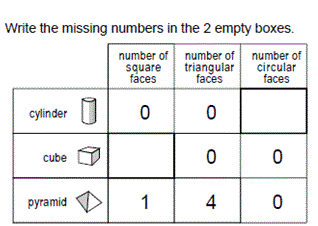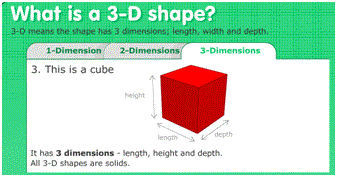| Programme of Study statements |
Activities |
| A |
B |
C |
D |
E |
| Identify and describe the properties of 2-D shapes, including the number of sides and symmetry in a vertical line |
|
|
|
|
|
| Identify and describe the properties of 3-D shapes, including the number of edges, vertices and faces |
|
|
|
|
|
| Identify 2D shapes on the surface of 3-D shapes, for example a circle on a cylinder and a triangle on a pyramid |
|
|
|
|
|
| Compare and sort common 2-D and 3-D shapes and everyday objects |
|
|
|
|
|
Children think about how much modelling clay and straws they would need to create outlines of 3D shapes.
How many balls of modelling clay and how many straws does it take to make the cube?
Here are some piles of modelling clay balls and straws:
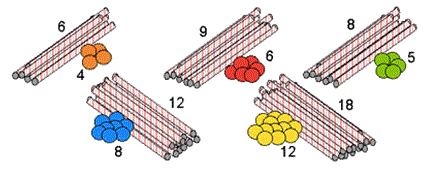
Look at the shapes below and decide which piles are needed to make a skeleton of each shape.
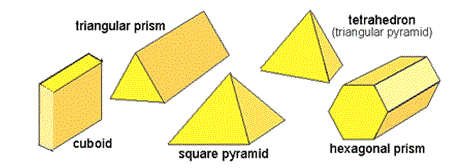
Stage: 1
Why do this problem?

This problem requires learners to visualise 3D shapes, and therefore consolidates knowledge of their properties. Pupils are also reminded that there is not necessarily one right answer in mathematics!
This problem uses simple shapes on cards in three colours for sorting data in different ways. Some excellent extension ideas for moving the children on in their understanding of shape.
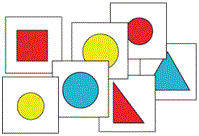
If you would like to make your own cards like these they can be downloaded from NRICH using the link above.
Activity D: Dismantling Boxes
– Haylock and Cockburn, Page 200
Haylock, D. (2008). Understanding Mathematics for Young Children Available: 978-1-4129-4726-8
Objective: To help children identify the plane shape forming the constituent parts of a solid shape
Materials: Ask the children to bring in 2 each of any interestingly shaped boxes from home, ideally from the family shop. If necessary supplement these with your own examples: cylinder, pyramids, tetrahedral, cubes, cuboids, prisms.

Activity: The children should go round the edges of one of one of the boxes with a thick, preferably black, marker. Then they dismantle the box, cut out, and identify the shapes that have been marked out. Discard any flaps. The complete box in the pair, and the cut out shapes from the other are then put in a display to show the various flat surfaces used to make the solid shape.

Activity E: Stolen Shape
Haylock and Cockburn, Page 197
Haylock, D. (2008). Understanding Mathematics for Young Children Available: 978-1-4129-4726-8
Objective: To develop young children’s ability to sort shapes according to attributes
Materials: to differentiate consider breadth of knowledge and use a variety of
- Plastic shapes – 2 D (colour, size, shape) Expand selection to include more names and variations on family group (Polygons, Triangles)
- Plastic shapes – 3D (colour, size, shape) Expand selection to include more names and variations on family groups (Tetrahedra, Prisms)
- Real life objects – 3D
Activity: First, two or three children discuss the shapes and work together to sort them into different categories. Perhaps the children can annotate their categories with signs, symbols. Given the opportunity to present their findings children may design their own display, labelling, table of results? Supporting their discussion by providing the language prompts, ensuring the children understand the language needed to discuss properties. Do the children know how to think, share their thoughts with others, and listen to the ideas of others? How can you support their findings and ideas, though annotation, scaffolding where necessary (EAL/ SEN)?
Then the children take turn to close their eyes while the shapes are jumbled back up. The teacher, adult or child in the group then ‘steals’ a shape. The children open their eyes and have to work out, through discussion, which shape has been stolen. Once decided they must describe it to the teacher, adult or child “the large red circle”. Once mastered the number of shapes ‘stolen’ could be increased.
What ways do the children record their solutions, annotate their findings?
How does the correct use of language support their conversation, and their generalising (talk) about shape?
Useful Resources
Lolly sticks, string, elastic, drinking straws and modelling clay (or even marshmallows if this does not contravene any of your school’s policies - Healthy Schools, H&S etc), boxes of shapes, paper for folding and cutting, a range of interestingly shaped containers.







